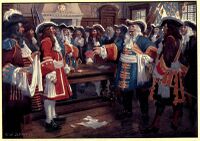Louvian Revolutionary War
From Kwikipedia, the free encyclopaedia
| Louvian Revolutionary War | |||||||||
|---|---|---|---|---|---|---|---|---|---|
 Important events of the war | |||||||||
| |||||||||
| Belligerents | |||||||||
| |||||||||
| Commanders and leaders | |||||||||
| Strength | |||||||||
| 42,000 regulars and militia |
48,000 regulars 15'000 loyalists | ||||||||
| Casualties and losses | |||||||||
|
9,650 dead in battle 7,100 wounded | 10,500 dead in battle | ||||||||
The Louvian Revolutionary War(September 5, 1758 – July 15, 1761) secured a Louvier independent from Lysian Republic. It is also called Guerre d'Indépendance de Louvier in Lysian. Fighting began on September 5, 1758, followed by the Declaration of Independence on October 6, 1758. The Louvian Patriots were supported by ? and ?, conflict taking place in Aurelia.
Causes
The unrest in the remote metropolis of Lysia had been stirring public opinion since 1755. In addition, the harsh winters of 1745 and 1750 were still felt and led the governor to tax the population even more to succeed in filling the financial abyss that affected the kingdom. Unrest soon broke out in the main towns of the colony such as Montvert, Saint-Philippe and Hautes-Plaines. Understanding that the situation was becoming tense in the colony, a first garrison of 5,000 men was sent to Saint-Philippe to support the soldiers already there. This only exacerbated the discontent of the population and, despite attempts at slight changes to the taxes put in place by Jean-Louis Meunier, soon the aristocrats of the colony began to secretly prepare an uprising to eliminate the unjust taxes.
Rupture
On September 5, 1758, an angry crowd gathered in front of Saint-Philipe's Town Hall to exert pressure. Following a misunderstanding or confusion, the garrison stationed in front of the town hall fired on the crowd, killing 12 people. It did not take more than that for the colonists' opinion on Lysia to fall drastically to be seen as an enemy. The evening after the massacre, the aristocrats helped by some military leaders including a captain named Antoine de Marelle, met in Pierre Lignoy's apartments and began to draft a declaration of independence. Declaring themself free from Lysian oppression and temporarily appointing a National Committee (In Lysian : Comité National) while waiting for a monarch. Posters began to be distributed to all towns and villages to announce independence. Opinion was divided: In the West the Louvians rejoiced at this news while in the East such a decision was castigated and openly criticized this aggressive approach. The two camps were now formed: the Loyalists and the Lysians in the East and the Patriots in the West.
Outbreak of war
The first fighting was unleashed at Fort Beauregard in early November, where the garrison refused to open to Lysian soldiers. To the cry of "Vive la liberté et vive Louvier!", the soldiers entrenched in the fort shot at the Lysians who had to quickly retreat. As the first ships of Lysian troops arrived to help in the future conflict that was coming, the governor of Saint-Philippe, now entrenched in Port la Joye, announced that: "All persons taking up arms against the Lysian crown will be punished by death." An army of Loyalists was quickly set up under the supervision of General Henri Moulin. The first real confrontation was at Saint-Philippe in December where the militiamen defended the city against the loyalists supported by the Lysian troops. The city held firm and General Sébastien Pierrac had to retreat with 300 casualties.
On December 28, 1758, loyalist troops led by Etienne Villeney on their way to Fleur-de-Lys were ambushed by natives and militiamen. The troops were almost all massacred and despite the national committee's request to try to take prisoners, the Indians showed nameless savagery and scalped the loyalist soldiers without the militiamen intervening to stop them.Captain Etienne Villeney was killed in this ambush of a tomahawk in the back.
Soon the lack of powder was felt for the Patriots, the reserves being at Port la Joye in Loyalist territory. It was necessary as soon as possible to try to take the city to supply the militia and the very recent Army of Louvier, freshly formed and led by patriotic officers who had served in the Lysian army, was sent to besiege the city. A naval expedition was authorized and the city was besieged from January 7, 1759 to January 12. As the winter made it difficult to arrive food, the city agreed to provide stocks of powder if the citizens were left in peace. Soon the announcement of a Lysian army approaching to rescue the city, shortened the time the Patriots had to load the powder. The ships left the port just in time before reinforcements arrived in the distance.
(WIP)
